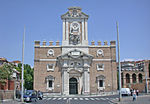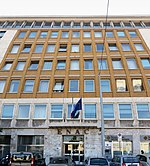1946 British Embassy bombing
The bombing of the British Embassy at Porta Pia in Rome was a terrorist action perpetrated by the Irgun that occurred on 31 October 1946. Two timed explosives encased in suitcases were planted by the Embassy's front entrance; the resulting blast injured two people and damaged the building's residential section beyond repair. The Irgun targeted the Embassy because they considered it an obstacle to illegal Jewish immigration into Mandatory Palestine. One of the Irgun's intended targets, ambassador Noel Charles, was away on leave during the attack. It was quickly determined that foreign militants from Mandatory Palestine were behind the attack and under pressure from Great Britain, the Italian police, Carabinieri and the Allied Police Force rounded up numerous members of the Betar organization, which had recruited militants from among the displaced refugees. Confirming fears of the expansion of Jewish terrorism beyond Mandatory Palestine, the bombing of the Embassy was the first attack against British personnel by the Irgun on European soil. The British and Italian governments commenced an extensive investigation and concluded that Irgun operatives from Mandatory Palestine organized the attack. The attack was condemned by the leaders of Jewish agencies superintending their refugees. Italy subsequently enacted strict immigration reform and antisemitic sentiment heightened in the United Kingdom. During the early 1950s, Israel lobbied the British to pressure the Italian government not to pursue the militants. In 1952, eight suspects–including ringleader Moishe Deitel–were tried in absentia and received light sentences ranging from 8 to 16 months.
Excerpt from the Wikipedia article 1946 British Embassy bombing (License: CC BY-SA 3.0, Authors).1946 British Embassy bombing
Via Palestro, Rome Municipio Roma I
Geographical coordinates (GPS) Address Nearby Places Show on map
Geographical coordinates (GPS)
| Latitude | Longitude |
|---|---|
| N 41.90900797 ° | E 12.50128161 ° |
Address
Via Palestro
00185 Rome, Municipio Roma I
Lazio, Italy
Open on Google Maps











